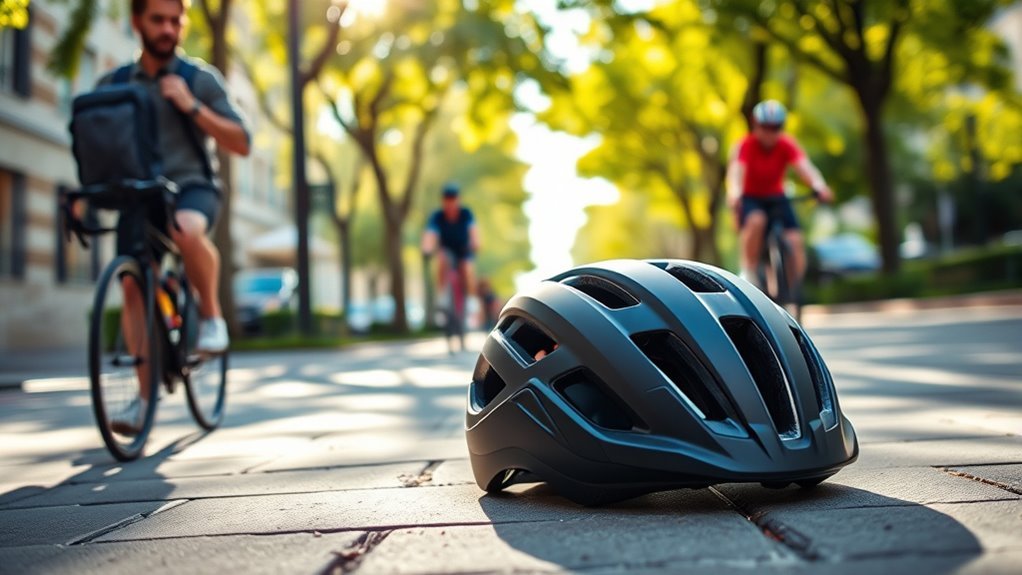Helmet Weight Considerations for Daily Commuters
When choosing a helmet for daily commutes, consider weight as it directly affects your comfort and fatigue levels. Heavier helmets may compromise your sense of freedom and lead to discomfort during longer rides. While lighter options enhance comfort, they must still meet safety standards to protect you effectively. Look for well-fitted helmets that balance weight, ventilation, and protection. Understanding these factors can lead you to a better commuting experience as you assess your unique needs.
The Impact of Helmet Weight on Comfort

When you’re commuting, the weight of your helmet can greatly influence your overall comfort during the ride. A heavier helmet may lead to fatigue, especially on longer journeys, detracting from your sense of freedom. To enhance comfort, consider helmets with optimized comfort features like padding and ventilation systems. These features can help balance weight while maintaining a snug helmet fit, which is essential for both comfort and performance. A well-fitting helmet distributes weight evenly across your head, minimizing pressure points that could cause discomfort. Ultimately, choosing a lightweight helmet with the right comfort features can markedly enhance your commuting experience, allowing you to focus on the road ahead rather than the burden on your head.
Safety vs. Weight: Finding the Right Balance

While a lightweight helmet can enhance comfort during your commute, it’s vital to guarantee that safety isn’t compromised in the process. Helmets must meet stringent safety standards to protect you effectively during unexpected incidents. A helmet’s weight distribution plays an essential role in not only comfort but also its protective capabilities. A well-balanced helmet that adheres to safety standards won’t strain your neck or head, allowing you to ride freely. However, opting for extremely lightweight materials can sometimes mean sacrificing important safety features. Consequently, you need to carefully assess the trade-off between weight and protection. Ultimately, finding that right balance assures you enjoy your ride while staying safe and secure on the road.
Factors Influencing Helmet Weight

Although you might prioritize comfort and safety when selecting a helmet, several factors greatly influence its weight. The choice of design materials plays a vital role; lightweight composites, like carbon fiber or expanded polystyrene, can considerably reduce overall weight without sacrificing protection. Additionally, the helmet’s ventilation system impacts weight—more vents typically mean a lighter helmet, but they can compromise structural integrity. A well-designed helmet balances adequate ventilation with effective weight distribution, ensuring you maintain freedom of movement while riding. Consider the trade-offs between materials, ventilation, and protection when making your choice, as each aspect contributes to the overall experience of comfort and safety during your daily commute.
Lightweight Helmet Options for Commuters
As you navigate the options for lightweight helmets, it’s essential to evaluate models specifically designed for urban commuting. Many manufacturers utilize lightweight materials such as expanded polystyrene and polycarbonate, minimizing bulk without sacrificing safety. Look for helmets that feature an adjustable fit system, ensuring comfort and stability during your ride. A properly fitted helmet stays securely in place, allowing you to focus on the freedom of your commute rather than adjusting your gear. Brands like Giro and Specialized offer innovative designs that emphasize both protection and agility. By choosing a helmet that combines lightweight construction with an adjustable fit, you’ll enhance your daily commuting experience while prioritizing safety and comfort. Enjoy the ride, knowing you’re protected without the added weight.
Tips for Choosing the Best Helmet for Your Commute
When selecting a helmet for your daily commute, it’s important to evaluate several factors that go beyond just weight. Consider your commuter preferences, such as ventilation, fit, and style. Different helmet styles can notably impact comfort and safety during your ride.
| Factor | Importance |
|---|---|
| Ventilation | Keeps you cool and comfortable |
| Fit | Guarantees safety and stability |
| Style | Reflects your personality |
Choose a helmet that balances protection with your individual needs. Lightweight options usually offer better comfort for longer rides, but make certain they meet safety standards. Ultimately, the best helmet aligns with your unique commuting lifestyle while keeping you protected.
Frequently Asked Questions
How Often Should I Replace My Helmet?
You should replace your helmet every three to five years, like revitalizing a wardrobe to guarantee you’re always in style. The helmet lifespan is essential for maintaining helmet safety. Over time, materials degrade, and impact protection diminishes. If you’ve been in an accident or notice any visible damage, it’s time for a replacement, regardless of age. Prioritizing your safety guarantees you can enjoy your rides with the freedom you seek.
Can Helmet Weight Affect My Riding Speed?
Yes, helmet weight can affect your riding speed. A well-designed helmet with ideal weight distribution prevents fatigue, allowing you to maintain speed over longer distances. Heavier helmets can create drag and may slow you down, while lightweight options enhance comfort and agility. It’s essential to balance safety and performance; choosing a helmet that offers both protection and minimal weight can greatly improve your overall riding experience, giving you the freedom to ride faster and longer.
Do Heavier Helmets Offer Better Protection?
Heavier helmets can offer better protection, but it’s not just about weight. They often use heavier materials designed to meet safety standards, providing enhanced impact resistance. However, it’s vital to balance weight and comfort; a heavier helmet might be cumbersome, affecting your riding experience. Ultimately, it’s essential to choose a helmet that meets safety standards while ensuring you feel free and comfortable during your rides. Don’t sacrifice safety for weight alone.
Are There Specific Weight Limits for Helmets?
When it comes to helmet safety, think about that moment when a feather meets a stone—weight matters. While there aren’t strict weight regulations set in stone, most safety standards recommend helmets to weigh no more than 1,000 grams. This guideline guarantees you’re protected without compromising comfort. A lighter helmet can enhance your riding experience, allowing you the freedom to focus on the road ahead, not the burden on your head.
How Do I Properly Clean My Helmet?
To properly clean your helmet, start by removing the inner padding, if possible, and wash it with mild soap and water. For the outer shell, use a soft cloth and a gentle cleaner suited for the helmet materials. Avoid harsh chemicals that can damage the finish. Rinse and dry thoroughly before reassembling. Regular cleaning not only maintains your helmet’s appearance but also guarantees its performance and longevity, giving you the freedom to ride confidently.






